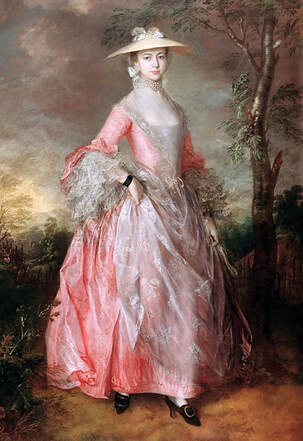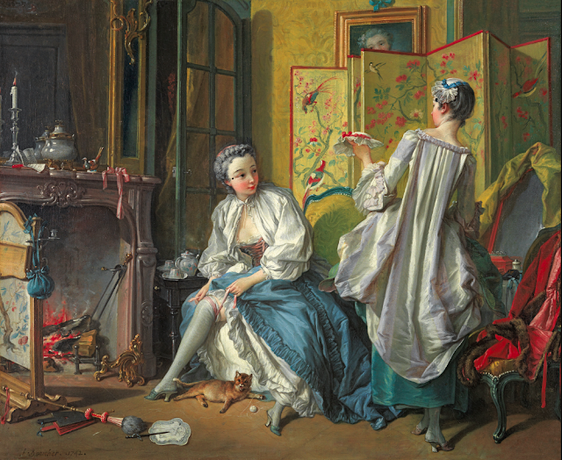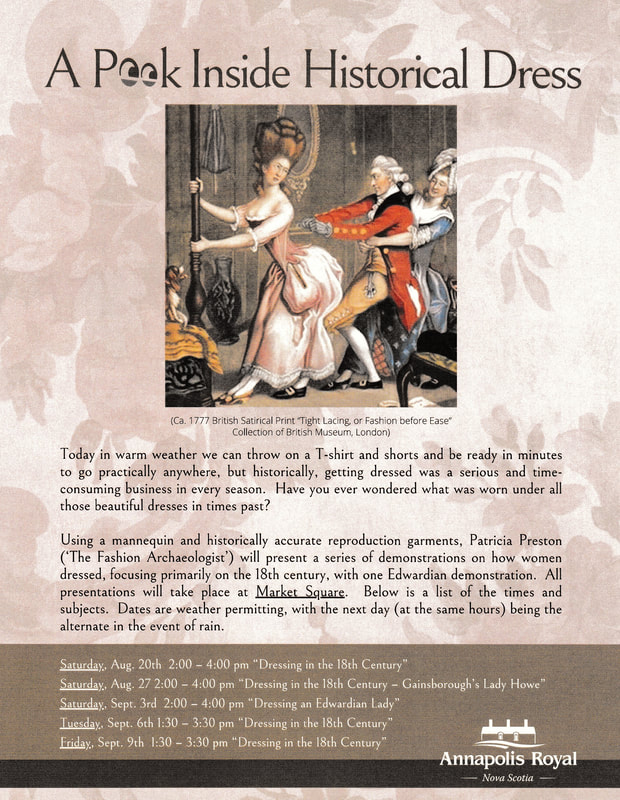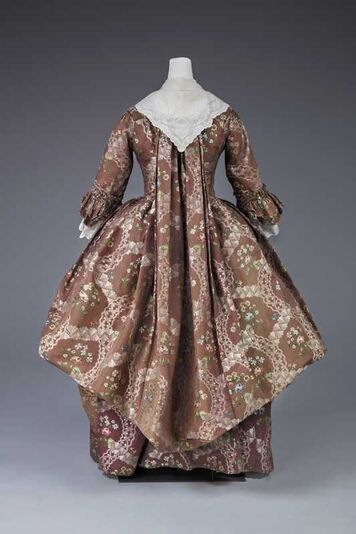|
In Part II in this series, I'll be looking at the 1760-65 era, with a focus on the dress depicted in Gainsborough's portrait of Lady Mary Howe, painted in about 1764, using replica garments based on those in the painting. I'll also discuss the connection of Lady Mary's husband, Richard Howe, to Canadian history of the time. Although most aspects of women's middle to upper middle class dress of the 1760's remained as they had been a decade before, there were subtle changes, which will be demonstrated in my talk. The presentation is planned to be held in Market Square in Annapolis Royal beginning at 2:00 pm on Saturday, August 27th, but as always, weather will determine if it can go ahead. The rain/alternate date will be Sunday, August 28th. For an overview of the typical elements of female dress of the mid-18th century, with photos of extant museum pieces and paintings, download the PDF document below.
If you're interested in details on my work making the replica of Lady Mary's ensemble, see the link below (the blog is in 4 parts):
0 Comments
During August and early September this year (2022), as part of my historical interpretation work with the Town of Annapolis Royal, I'll be presenting a series of free talks on how women dressed in historical times. See the copy of the flyer below for details of dates and times. Part I, which takes place on Saturday, August 20th beginning at 2:00 p.m. in Market Square in Annapolis Royal, will be a demonstration, using historically accurate reproduction garments (on a mannequin), of the typical fancy dress of a British middle to upper-middle class lady, around 1750 to 1755. The PDF document below provides descriptions and examples of the elements of dress of the period which I'll be displaying and discussing. Download the PDF document for reference or -- if you have a mobile phone with you on which to download -- follow along if you are attending the talk. I hope to see you there!
Here is the flyer with the schedule for the entire series (some topics will be repeated later on).
Absorbing Surprises in Historical Costume (a.k.a. Fashions that shouldn't exist) As a fashion historian I always try to be aware of what I call “absolutism” when thinking about or discussing historical costume. One of the easiest and most enticing traps to fall into where historical dress is concerned (particularly for time periods prior to the mid-19th century) is making unconditional statements or conclusions based on what is necessarily a limited supply of evidence.
I've always believed that the further back in time one goes, the less justifiable it is to indulge in "fashion absolutism", i.e. rule-making. This is often proven true with the sudden appearance on the open market of an historical garment in a style or construction that "should not exist". Avoiding such difficulties is essentially a matter of seeing beyond what might ordinarily seem to be settled borders of history. Put another way, it means training the eye and mind to accept what is really there, sometimes without being able to fit an item neatly into a previous category. This is especially the case where the 18th century is concerned, in fact for any time prior to about 1860, when photography and mass-market print publications became widely available, giving us a more direct window into what people wore. |
AuthorPatricia Preston, a.k.a. The Fashion Archaeologist, Historian, linguist, pattern-maker, enthralled by historical fashion, especially the 18th, 19th and 20th centuries.. Archives
August 2022
Categories
All
|
||||||||||||
Site powered by Weebly. Managed by Dot5Hosting





 RSS Feed
RSS Feed